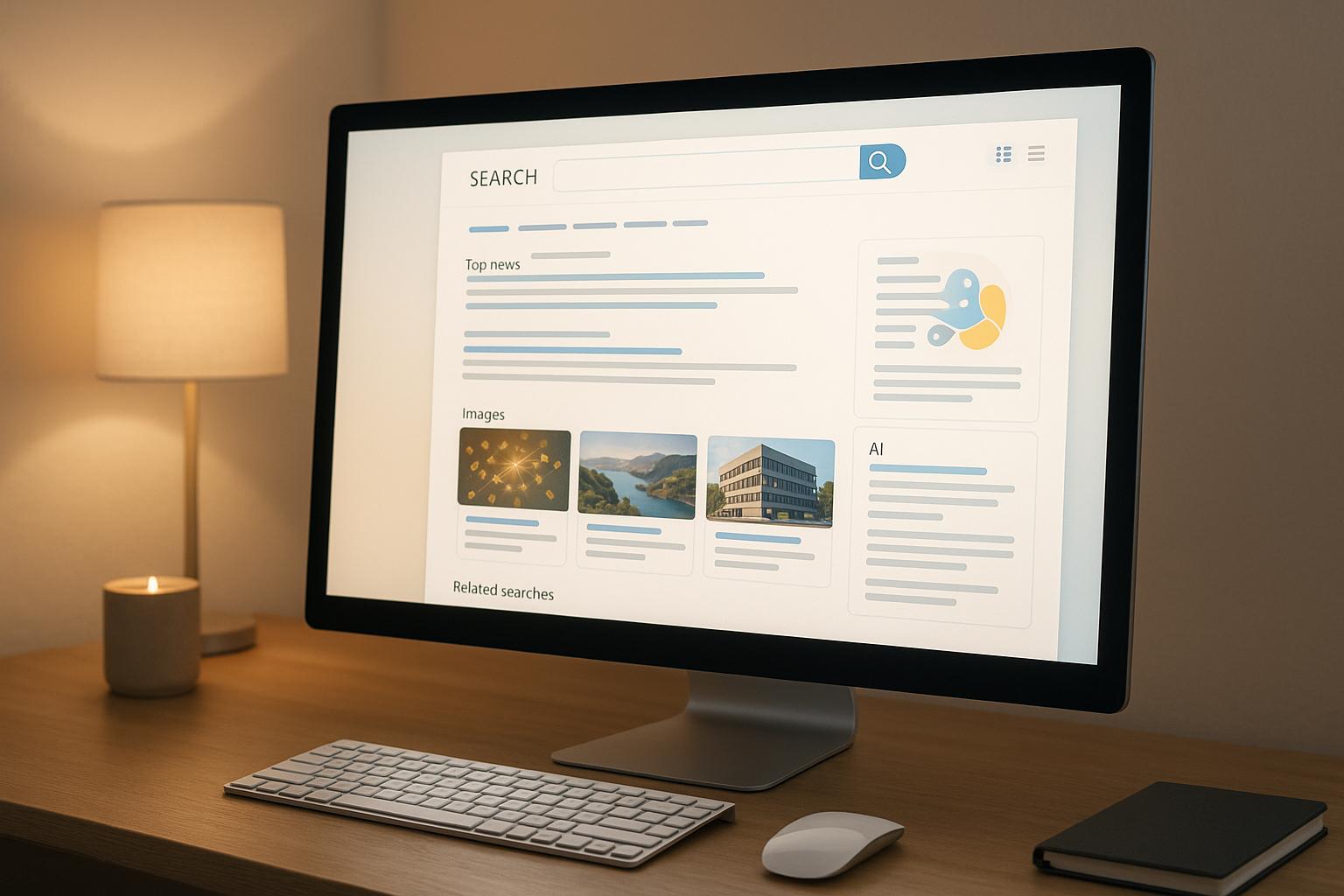Bing’s 2025 algorithm update has overhauled how search results are ranked and displayed. Here’s what you need to know:
- AI-Powered Search: Bing now uses advanced natural language processing (NLP) and large language models (LLMs) to better understand user intent and deliver more accurate search results.
- Content Quality Focus: The algorithm prioritizes high-quality, trustworthy content, especially for sensitive topics like health and finance.
- User Engagement Metrics: Factors like dwell time, click-through rates, and bounce rates now directly influence rankings.
- Unified Indexing: Bing uses a single index for mobile and desktop, ensuring consistent results across devices.
- Generative Search Integration: AI-generated summaries now appear alongside traditional search results, improving the user experience.
These changes emphasize creating user-focused content, improving page speed, and leveraging social media engagement to stay competitive on Bing. With over 1.1 billion monthly searches, Bing’s updates present new opportunities for businesses aiming to enhance visibility and reach.
Bing Machine Learning & Crawling Changes, Google Search Console Updates, Advertiser Poaching & More
Key Changes in the 2025 Bing Whole Page Algorithm
Bing’s 2025 update introduced five major shifts in how the search engine evaluates and ranks web content. These updates aim to provide more precise, user-centered search results, powered by advanced AI capabilities. Here’s a breakdown of the key changes.
Improved Natural Language Processing (NLP)
Bing’s enhanced NLP goes beyond basic keyword matching to better understand context and user intent, even in conversational queries. This means the search engine can interpret implied meanings and recognize variations in how users phrase similar questions. It also evaluates semantic relationships across entire web pages, prioritizing content that directly addresses what users are looking for.
Stronger Emphasis on Content Quality
Content quality now plays a bigger role in rankings, with Bing heavily relying on the E‑A‑T framework (Expertise, Authoritativeness, Trustworthiness). This is especially important for YMYL (Your Money or Your Life) topics, where accuracy and reliability are critical. Bing prioritizes well-written, trustworthy, and topic-focused content, encouraging creators to produce original material that meets user needs.
User Engagement Metrics as Ranking Factors
Metrics like dwell time, click-through rates, and bounce rates are now significant ranking signals. Content that keeps users engaged is rewarded with higher rankings. Bing’s AI-driven features aim to reduce the need for external clicks, so content must be compelling enough to hold attention. Pages that include rich media (like images and videos) and structured data are also favored, aligning with Bing’s push toward multimodal search experiences.
Unified Indexing for Mobile and Desktop
Unlike adopting a mobile-first indexing approach, Bing continues to use a unified index optimized for both desktop and mobile. As Christi Olson of Bing put it:
"We maintain a single index that is optimized for both mobile and desktop to ensure our users continue to receive the most relevant, fresh, and consistent results no matter where they are."
This approach ensures a seamless user experience across all devices.
Integration of Advanced AI Technology
Bing’s advanced AI tools are reshaping search interactions. With a focus on conversational AI and contextual results, Bing Generative Search uses large language models (LLMs) to deliver dynamic, context-aware responses. AI is also improving local search by factoring in elements like locality, business reputation, and customer reviews. With over 1.1 billion monthly searches globally and accounting for about 12% of desktop searches worldwide, these updates aim to make Bing’s search experience more personalized and engaging.
Impact on Search Rankings and User Experience
Bing’s algorithm updates have brought significant changes to both website rankings and how users interact with its search platform. The 2025 update has reshaped search result dynamics, influencing short-term ranking shifts and long-term visibility trends across various types of content.
Ranking Changes and Visibility Shifts
The update has prioritized high-quality, expert-driven content while pushing outdated and lower-quality material further down in search results. Websites offering thin content or lacking strong engagement metrics have experienced noticeable declines, while those focusing on well-rounded, frequently updated content have seen their rankings improve. Bing’s algorithm now places a stronger emphasis on content freshness, rewarding sites that regularly update their key pages with better visibility.
Another notable factor is the role of social media engagement in rankings. Pages with strong visibility on platforms like LinkedIn and Facebook can now gain an edge in Bing’s search results, giving businesses with active social media strategies a boost. These changes underline the importance of monitoring user behavior and engagement metrics to stay competitive.
How User Satisfaction Signals Matter
Engagement metrics now play a direct role in Bing’s ranking decisions. According to Bing’s webmaster guidelines, the search engine evaluates user interactions with search results to determine relevance. Click-through rates (CTR) are a key indicator – low CTR suggests that content may not align well with user intent. Similarly, dwell time is critical; spending 90 seconds or more on a page signals valuable content, even if users don’t click further.
On the flip side, pogo-sticking – when users quickly return to search results – indicates dissatisfaction with the content. Bing tracks these behaviors on a keyword-by-keyword basis, meaning content performance can vary significantly depending on the search terms driving traffic. Page load speed also impacts these metrics. Studies show that even a 100-millisecond delay can reduce conversion rates by 7%, while a 2-second slowdown can decrease queries per user by 1.8% and revenue per user by 4.3%.
Changes in Bing’s Search Result Layout
Bing has also revamped its search results layout to enhance user experience. In July 2024, the platform introduced Bing Generative Search, which integrates generative AI and large language models into traditional search results. This update delivers more dynamic and detailed responses to user queries.
The new design blends information with visually rich elements, creating a more engaging search experience. Unlike zero-click search formats, Bing’s layout retains traditional search results alongside AI-generated content, ensuring that users still have access to clickable links, references, and citations. This approach helps maintain website traffic while offering a richer search experience.
Local search results have also been enhanced. Instead of focusing solely on the user’s immediate surroundings, Bing now aggregates data from various sources to provide a broader perspective on location-based queries. This gives users more context while still driving traffic to local businesses.
Additionally, the generative search experience anticipates follow-up questions related to the initial query, presenting comprehensive information that addresses these potential inquiries. Microsoft designed this feature to support the broader web ecosystem, with early data showing that it maintains healthy click-through rates to publisher websites.
"We are continuing to look closely at how generative search impacts traffic to publishers. Early data indicates that this experience maintains the number of clicks to websites and supports a healthy web ecosystem. The generative search experience is designed with this in mind, including retaining traditional search results and increasing the number of clickable links, like the references in the results." – Microsoft
These updates reflect Bing’s strategy to stay competitive in the evolving AI-powered search landscape while ensuring that publishers and businesses continue to benefit from web traffic and revenue opportunities.
sbb-itb-880d5b6
Bing Whole Page Algorithm: Before vs. After the Update
In 2025, Bing introduced a major overhaul to its algorithm, reshaping how search results are ranked and displayed. This update brought significant shifts in how Bing interprets queries, evaluates content, and prioritizes user experience, making it essential for website owners and SEO professionals to adjust their strategies.
A standout change lies in how Bing processes search queries. Previously, the algorithm heavily relied on exact keyword matches and traditional ranking signals. After the update, Bing’s AI-driven natural language processing (NLP) took center stage, enabling it to better understand context and user intent.
Content evaluation also saw a major shift. Before the update, Bing focused on keyword density, rewarding pages that repeated specific terms. Now, the emphasis is on content depth, completeness, and E‑A‑T (expertise, authoritativeness, and trustworthiness). This marks a clear pivot toward prioritizing quality over sheer volume.
User engagement metrics have become a critical part of Bing’s ranking criteria. The updated algorithm actively monitors behaviors like click-through rates, dwell time, and whether users quickly return to the search results page. These signals help Bing determine which pages truly satisfy user intent.
The layout of search results has also been reimagined. In July 2024, Microsoft unveiled a design that places AI-generated summaries prominently at the top of the page, while traditional search results are relegated to a narrow column on the right. This is a stark departure from the earlier, straightforward list format.
Social engagement now plays a role in rankings, as Bing factors in signals like shares, likes, and other interactions. Here’s a breakdown of the key differences between the pre- and post-update algorithms:
| Algorithm Aspect | Before 2025 Update | After 2025 Update |
|---|---|---|
| Query Processing | Exact keyword matching, basic relevance signals | AI-driven natural language processing, semantic understanding |
| Content Evaluation | Keyword-centric approach, density focus | Content completeness, E-A-T principles, credibility assessment |
| User Engagement | Limited emphasis on behavioral signals | Active monitoring of click-through rates, dwell time, and quick return to search results |
| Search Results Layout | Traditional list format | AI-generated summaries with traditional results in a right column |
| Mobile Indexing | Mobile-friendly consideration | Mobile-first indexing priority |
| Social Signals | Minimal impact on rankings | Social engagement considered as ranking factor |
| Content Freshness | Basic recency signals | Strong emphasis on regular content updates |
| Page Speed Impact | General performance consideration | Critical factor: 100ms delay = 7% conversion drop |
These updates highlight Bing’s dedication to delivering a more precise and user-focused search experience. For instance, page speed has become a critical ranking factor, with even slight delays in loading potentially affecting a site’s visibility.
Microsoft’s investment in advancing Bing’s algorithm underscores its goal to create a smarter, faster platform that stands out in the AI-driven search landscape. As the company puts it:
"It understands the search query, reviews millions of sources of information, dynamically matches content, and generates search results in a new AI-generated layout to fulfill the intent of the user’s query more effectively".
For SEO professionals, the takeaway is clear: success now hinges on creating content that is not just optimized for search engines but genuinely valuable to users. By focusing on quality, engagement, and relevance, websites can thrive in this new search environment.
How to Adapt to Bing’s Algorithm Changes
With Bing’s 2025 update shaking things up, adjusting your SEO strategies is essential to stay ahead. Bing, which handles over 1.1 billion monthly searches and boasts users with higher spending power, requires a fresh approach to content, technical SEO, and monitoring. Here’s how you can make these updates work for you.
Content Strategies That Work
Bing rewards content that’s clear, focused, and directly addresses user intent. Aim for material that’s well-written, reliable, and sticks to a single topic.
Keyword optimization remains a cornerstone. Place exact-match keywords in your title tags, H1, and opening paragraph. Naturally weave relevant keywords throughout your content to ensure it aligns with search queries. Don’t overlook meta descriptions – they should be enticing and include your target keyword to improve click-through rates.
Structure your content with subheadings (H2s and H3s) to create a logical flow. Enhance the user experience by incorporating descriptive visuals like images and videos. Be sure to add alt text to these elements – it improves accessibility and helps Bing better understand your content.
Keeping your content fresh is another priority. Regularly update key pages, especially for time-sensitive topics, to maintain Bing’s "freshness signal". Make sure your content is comprehensive enough to answer user questions fully, so they don’t need to look elsewhere for additional information. For local audiences, create location-specific landing pages featuring local keywords, addresses, and references to nearby landmarks or neighborhoods.
Finally, don’t underestimate the power of social media. Engaging posts can generate signals that Bing recognizes and values.
Technical SEO Best Practices
Once your content is optimized, technical SEO ensures Bing’s algorithm can properly rank it. Start with the basics: secure your site with HTTPS, as it’s a key trust signal. While Bing leans toward desktop results, having a mobile-friendly site improves user engagement significantly.
Page speed is critical. Bing emphasizes this in its guidelines:
"Slow page load times can lead a visitor to leave a website, potentially before the content has even loaded, to seek information elsewhere. In most cases, Bing will consider this a poor user experience and a less helpful search result."
Speed up your site by compressing files and choosing efficient hosting options.
Structured data is another must. Bing explicitly states:
"Structured data is one of the most direct ways to help Bing understand your content, and rank it more effectively."
Use Schema.org markup with JSON-LD or microdata to highlight key information on your pages. Validate your structured data using Bing’s Markup Validator to ensure everything is functioning properly.
If your content is designed for voice search platforms like Alexa or Cortana, implement the Speakable schema to improve visibility in voice search results. Additionally, focus on building a strong technical foundation by fixing broken links, using canonical tags correctly, and minimizing JavaScript-heavy elements that Bing may struggle to process.
Submitting an XML sitemap through Bing Webmaster Tools is another essential step. Regularly check for indexing errors like 404 pages or blocked URLs to keep your site running smoothly.
When it comes to link building, Bing prioritizes quality over quantity. As their guidelines explain:
"Often even just a few quality inbound links from trusted websites is enough to help boost your rankings."
Focus on earning links from credible, industry-relevant sources to strengthen your site’s authority.
Monitoring and Adjusting Your Strategy
Staying on top of Bing’s algorithm requires constant monitoring and fine-tuning. Bing Webmaster Tools should be your go-to dashboard for tracking keyword rankings, click-through rates, and crawl errors. Dive into search traffic data to pinpoint your top-performing pages and better align your efforts with Bing’s ranking signals.
Set clear goals and use tools like Microsoft Clarity to analyze user behavior. This can help you identify areas for improvement and optimize your site’s performance.
Experiment with different headlines, meta descriptions, and content formats to see what resonates most with your audience. Tools like Optimizely can help you run these tests and make data-driven decisions.
Remember, Bing’s metrics and priorities differ from Google’s. As Anastasiia Pasteka, Middle SEO Specialist, points out:
"It’s important to keep in mind that Bing and Google use fundamentally different search algorithms, so insights from Bing Webmaster Tools won’t always align with user behavior on Google."
Stay updated on Bing’s algorithm changes by following their official channels and exploring their suite of free SEO tools. Bing even allows direct contact with their webmaster team, offering a helpful resource for guidance when needed.
Regular reviews of your performance – identifying top-performing content, resolving technical issues, and adapting to changing user behavior – will keep your SEO strategy aligned with Bing’s evolving priorities.
Conclusion
Bing’s 2025 whole page algorithm update signals a significant transformation in how the search engine evaluates and ranks content. This update introduces advanced natural language processing, a stronger focus on content quality, user engagement metrics as ranking factors, mobile-first indexing, and deeper AI integration. For businesses looking to improve their search visibility, these changes present both challenges and opportunities. They don’t just alter search rankings – they also set a higher bar for creating meaningful user experiences.
Currently, Bing handles over 1.1 billion searches each month. In the U.S., its desktop queries often lead to higher purchase values, highlighting its untapped potential for businesses aiming to reach valuable audiences. These algorithm updates reflect Bing’s dedication to improving user experiences through its AI-driven search capabilities. As Anastasiia Pasteka, a Middle SEO Specialist, points out:
"It’s important to keep in mind that Bing and Google use fundamentally different search algorithms, so insights from Bing Webmaster Tools won’t always align with user behavior on Google… That’s why a well-rounded SEO strategy should account for the unique characteristics of each search engine individually."
To stay competitive, adapting quickly to these updates is key. Bing now rewards websites that produce high-quality, user-focused content, prioritize fast loading speeds, and actively engage users through social signals. At the same time, technical aspects like structured data and precise keyword optimization remain essential for success on the platform.
With its advanced AI capabilities and mobile-first approach, Bing is leveraging Microsoft’s ecosystem to cement itself as a major hub for content discovery and interaction. With 60 million users relying exclusively on Bing for their searches, overlooking this platform means missing out on a significant audience.
FAQs
What does Bing’s 2025 algorithm update mean for businesses looking to boost their search rankings?
Bing’s upcoming 2025 algorithm update is set to emphasize AI-powered search, natural language processing, and user engagement metrics like dwell time and click-through rates. For businesses, this signals the need to focus on producing reliable, well-researched content that meets the specific needs of their audience.
Equally important is refining the user experience – this includes faster site loading times, mobile-friendly designs, and seamless navigation. By tackling these aspects, businesses can align with the new algorithm and improve their chances of standing out in search results.
How do user engagement metrics influence Bing’s updated ranking system, and what steps can websites take to improve them?
User engagement metrics like click-through rates (CTR), dwell time, and return visits play a major role in Bing’s updated ranking system. These metrics give Bing a sense of how helpful and relevant your content is to users.
To make the most of these factors, aim to create engaging, user-focused content that directly matches what your audience is looking for. Make sure your website loads quickly, provides a smooth browsing experience, and includes clear calls to action. Use attention-grabbing titles and meta descriptions to encourage clicks and ensure visitors stay engaged once they land on your site. Focusing on user satisfaction can boost both engagement levels and your search rankings.
How can businesses use Bing’s AI-driven search updates to improve their content strategy?
Businesses can benefit from Bing’s AI-powered search updates by concentrating on producing content that prioritizes user needs and aligns with search intent. This means creating material that not only provides value but also reflects the way people naturally search and interact online.
To improve results, focus on key engagement metrics like dwell time and click-through rates. By developing well-organized, authoritative content that directly addresses user questions, you can boost your chances of appearing prominently in search results. Also, keeping up with Bing’s algorithm changes ensures your approach stays relevant as search trends evolve.




